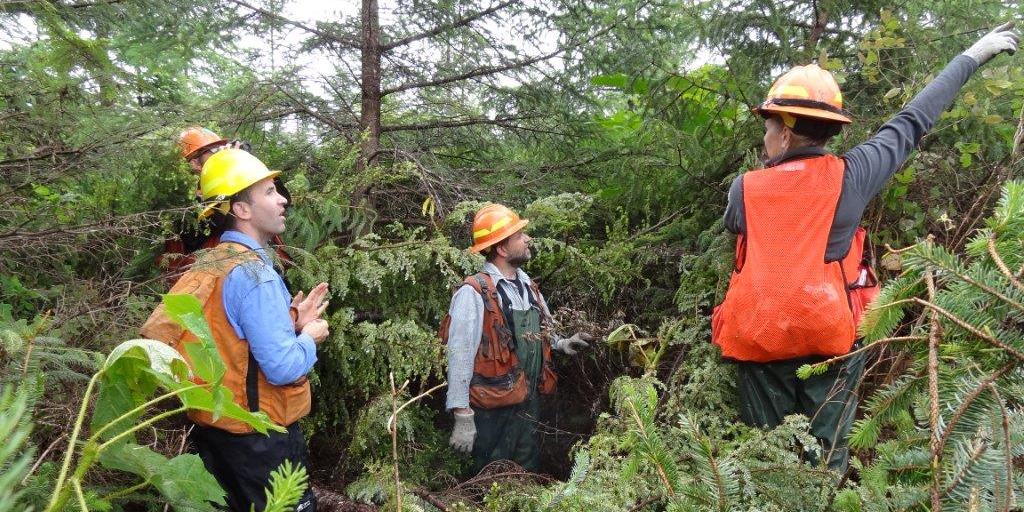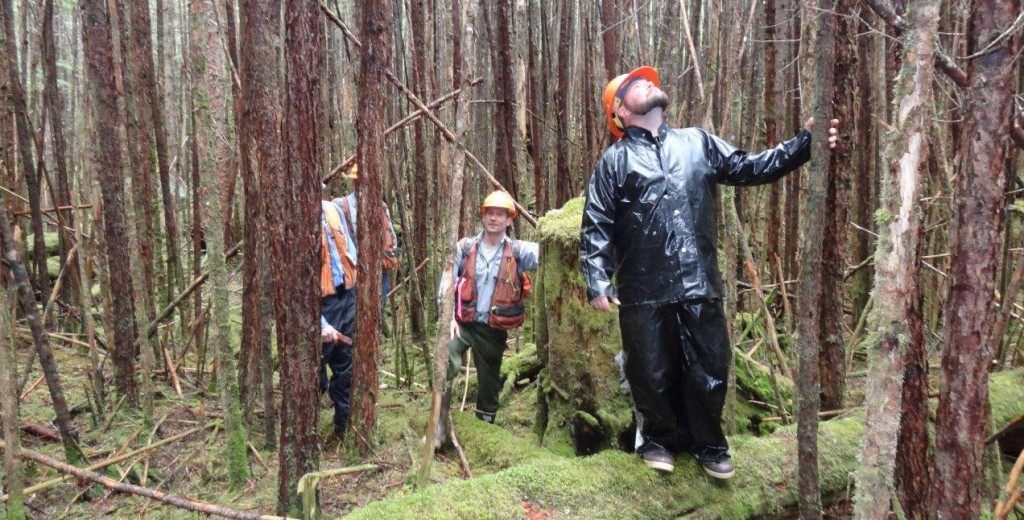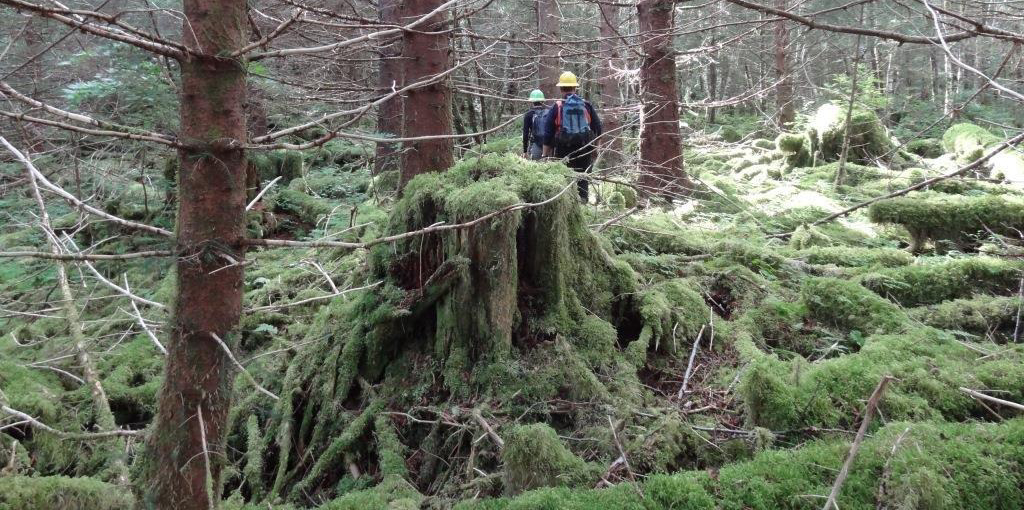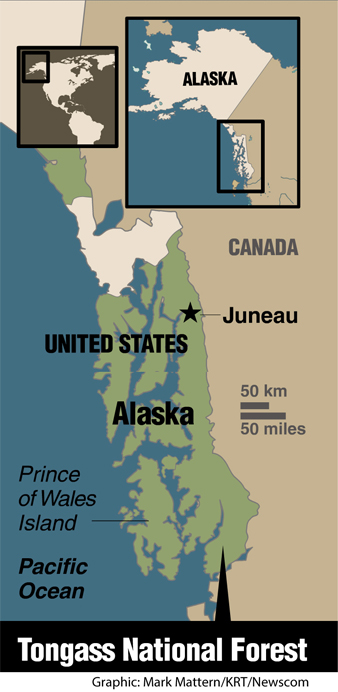Environmentalists Halt Obama Administration Plan to Cut Trees in Alaska
Ron Arnold /
A family-owned timber firm that operates the last significant sawmill in Alaska’s Tongass National Forest has won a momentous U.S. Forest Service contract: the Big Thorne Project, which will allow the harvest of nearly 150 million board feet of wood.
The Obama administration’s decision marks the transition away from old-growth timber and toward a sustainable forest industry based on young growth. More than a quarter of the trees in the contract are regrowth on previously logged sites, to be nurtured for a sustainable future.
But winning bidder Viking Lumber Company can’t begin the transition because at least five environmental groups are suing to “stop this massive old-growth clear cutting on public lands.” For years, environmentalists have tried to stop logging in old-growth forests—lands that are economically valuable because they have been growing for over a century.

Foresters survey Alaska coastal young growth in logged-over sites such as this for future timber to replace old growth in the forest industry—if transition plan is allowed to go forward. (Photo: U.S. Forest Service)
Kirk Dahlstrom, a Viking co-owner, told The Daily Signal he, his three brothers, and a partner moved to Alaska in 1994 “to escape old-growth lawsuits,” particularly the notorious Audubon Society spotted owl litigation.
Dahlstrom said, “The owl lawsuit took away the high-quality old growth we used for doors, framing and molding products” in their Hoquiam, Wash., sawmill.
Audubon’s lawsuit cost 22,654 logging and mill jobs in California, Oregon and Washington, according to final surveys. The Oregon Natural Resources Council’s Andy Kerr called the unemployed “collateral damage”—a despised underclass bloodied without consequence or conscience.
How “massive” is Viking’s Big Thorne contract? Tongass Forest Supervisor Forrest Cole gave The Daily Signal some perspective: “Big Thorne is a five-year project with a mix of 6,186 acres of old growth to help local businesses through the transition stage, and 2,299 acres of young growth.”
The young growth, Cole said, will be thinned to enhance wildlife habitat—mostly for deer—and to provide growing space for the best trees for tomorrow’s re-tooled young growth sawmills.
The Tongass is America’s largest national forest—at 17 million-acres, it is bigger than Vermont, New Hampshire and Massachusetts combined. It spans 500 miles of scenic Pacific Coast Range mountains, 300 miles of it fringed with the Alexander Archipelago’s 1,100 islands that shelter the iconic Inside Passage. Forests cover 10 million Tongass acres, and its 5.7 million acres of untouchable wilderness are bigger than New Jersey and Delaware together.
The Sierra Club, Natural Resources Defense Council, National Audubon Society and others are blocking a sustainable future over Big Thorne’s “massive” 6,186 acres of old growth. (That’s about half the size of Washington’s Dulles International Airport.)
But this time they’re not attacking a marginalized minority.
The Obama administration itself ordered Big Thorne’s old-growth logging. In a July 2, 2013, memorandum, Secretary of Agriculture Tom Vilsack ordered the Forest Service “to supply sufficient old growth ‘bridge timber’ while the industry re-tools for processing young growth. The first step is the Big Thorne timber sale.”

Favorable growing conditions can turn logged sites into a “skinny toothpick factory” like this, but selective thinning lets the best young trees grow into sizeable replacements for old growth. (Photo: U.S. Forest Service)
Alaska Gov. Sean Parnell, a Republican, was furious at “irresponsible lawsuits by environmental groups to stop all logging,” and had the state file motions in federal court challenging them, saying, “We will help defend the sale against those who want to kill Alaska’s jobs and shut down our traditional timber communities.”
U.S. Sen. Mark Begich, an Alaska Democrat facing a tough reelection, urged the Forest Service to monitor Viking’s wood supply “and take whatever steps are necessary to supply timber until such time as Big Thorne is available.”
Big Thorne, with its transitional mix of old growth and young growth, has become an incipient Beltway brawl. The Senate Environment and Public Works Committee’s top Republican, David Vitter of Louisiana, has taken note and asked his committee staff to track the forest industry nationwide, with good reason.
The staff recently reported on a “Billionaire Club” systematically designing and funding large numbers of environmental group campaigns attacking many industries. For example, the Rockefeller Brothers Fund gives millions to shut down Canada’s oil sands; Gordon Moore’s Intel-rich private foundation pays an Alaska group to “permanently” stop Tongass logging and much more.

Yesterday’s old-growth logging sites are capable of repeated cycles producing young-growth timber for tomorrow’s sustainable forest industry. (Photo: U.S. Forest Service)
Vitter told The Daily Signal, “Instead of finding a middle ground that promotes responsible forestry and jobs, these litigation-happy organizations are solely focused on shutting down the forestry industry and completely disregard the potential environmental benefits.”
Perhaps this time the Billionaire Club’s hubris will be the collateral damage and a sustainable forest industry will emerge. Wisdom says keep your eye on the prize.

